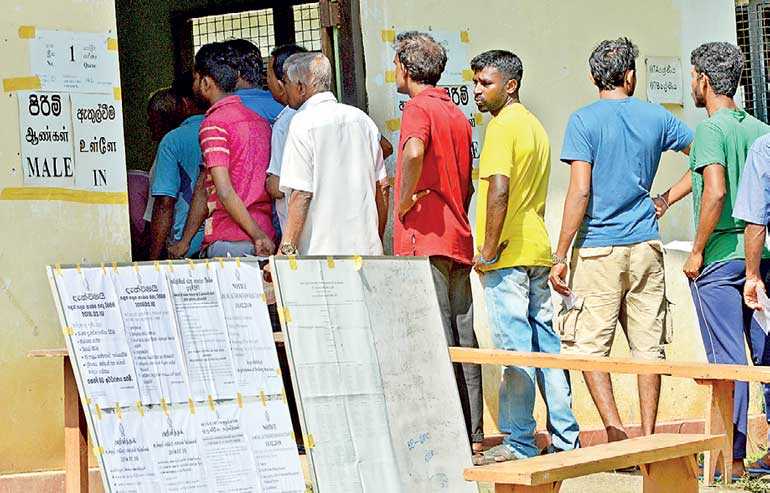Wednesday Feb 12, 2025
Wednesday Feb 12, 2025
Tuesday, 26 March 2019 00:00 - - {{hitsCtrl.values.hits}}

Major elections are round the corner. The politicians are already in discussions to make political alliances with the hope of getting more votes. Unfortunately not much regard is paid to policies or a plan for the country. The standard practice is to dish out a wish list as the election manifesto with no reasonable implementation plan.
Absence of such practical plans, results in formulating plans once elected. As that exercise is done hurriedly, the resulting plans do not tend to be sound which results in changing the plan frequently. Even those plans do not get implemented eventually, as they realise there is no consensus among parties within the alliance, as the alliances were not made based on economic policies but just to get more votes.
The flaws of past election manifestos
As little effort is put on formulating election manifestos, they usually end up as a list of promises and fairy tales. We usually hear long wish lists with no detail on implementation. The result is usually disappointing as once in power most promises do not get implemented in the absence of a practical implementation plan. Only the short term ‘vote buying’ measures such as increases in state sector salaries may get implemented which actually burdens the economy in the long run in the absence of an economic plan to afford such measures.
It is about time that the economy’s stakeholders demand for practical election manifestos which would guide the country over the next five years.
A 5-year plan
As the term of the mandate is five years, the plan should also be for five years. We have heard of 10-20 year plans which are meaningless in the absence of clearly identifying the goals within five years. The development roadmap could be for 10-20 years, although what would be achieved within five years should be clearly mentioned and quantified so that the performance could be evaluated during the course of the term.
Prioritising policy
As a developing country, Sri Lanka has a wide array of problems. A practical election manifesto should identify what issues would be prioritised. Everything cannot be done in five years and that’s why it should be a step-by-step process. Prioritising also helps to address the key issues more effectively, whereas trying to address many issues dilutes the effort in tackling the key issues. This is the very reason why countries have continuous 5 year, 10 year plans. Once the most pressing issues are addressed and the country elevates its position, the next set of issues could be addressed, and so on. The past experience shows that trying to address every issue ends up resulting in making very little progress in all issues.
Historically, an effort has not been made to study the prevailing situation and identify which factors need to be addressed urgently over the next five years. The stakeholders should demand the main parties to identify the top 5-10 issues that they would give priority to, and look at addressing in the coming five years.
For example, from an economic point of view from where Sri Lanka is right now, a critical factor is to boost household income (or per capita income) in a sustainable manner. That could be a prioritised issue in the manifesto.
Clear, quantifiable goals
Based on the prioritisation of issues, the manifesto should clearly indicate and quantify the level of progress that would be achieved during the five-year period.
To continue with the earlier example, if priority is to boost per capita income in a sustainable manner, the goal could be to increase it to $ 6,000 in five years from the current level of $ 4,000. Further the situation in five years should be such that growth could continue (sustain), which should mean the economic growth is not achieved by short term measures such as adhoc Government spending or misdirected tax concessions.
Implementation methodology
Finally, the manifesto should outline the implementation methodology. What exact steps would be taken to achieve the goals. In the above example, to boost per capita income in a sustainable manner, the plan could be to set up new industries to link Sri Lanka to global supply chains while providing employment.
It should specify what exactly the Government would do, rather than passing the responsibility to the private sector. For example, it could specify the investment by the Government (say Rs. 100 billion each year) to acquire technology or set up capacity in the form of training institutes, etc. It should also specify how such funds would be raised, for instance if it’s through borrowings it would mean an expansion of the budget deficit. It would be impractical to expect that all macroeconomic indicators could be improved in a relatively short span of time. To make meaningful progress in terms of critical issues, certain non-critical issues may have to be allowed to deteriorate to some extent.
Avoid ‘vote buying’ counter-productive measures
While marginal short term reliefs could be expected in an election manifesto, it shouldn’t be at a scale of burdening the economy. It is about time that masses realise that such measures have not been beneficial in the long run. For instance, adhoc salary increases in the Government sector by burdening the economy has resulted in sharp rises in cost of living, which have completely negated the increase in salaries.
It could be wishful thinking to expect a well thought out, practical election manifesto. But then again, one should never lose hope.
(The writers could be contacted via [email protected].)
Discover Kapruka, the leading online shopping platform in Sri Lanka, where you can conveniently send Gifts and Flowers to your loved ones for any event including Valentine ’s Day. Explore a wide range of popular Shopping Categories on Kapruka, including Toys, Groceries, Electronics, Birthday Cakes, Fruits, Chocolates, Flower Bouquets, Clothing, Watches, Lingerie, Gift Sets and Jewellery. Also if you’re interested in selling with Kapruka, Partner Central by Kapruka is the best solution to start with. Moreover, through Kapruka Global Shop, you can also enjoy the convenience of purchasing products from renowned platforms like Amazon and eBay and have them delivered to Sri Lanka.
Discover Kapruka, the leading online shopping platform in Sri Lanka, where you can conveniently send Gifts and Flowers to your loved ones for any event including Valentine ’s Day. Explore a wide range of popular Shopping Categories on Kapruka, including Toys, Groceries, Electronics, Birthday Cakes, Fruits, Chocolates, Flower Bouquets, Clothing, Watches, Lingerie, Gift Sets and Jewellery. Also if you’re interested in selling with Kapruka, Partner Central by Kapruka is the best solution to start with. Moreover, through Kapruka Global Shop, you can also enjoy the convenience of purchasing products from renowned platforms like Amazon and eBay and have them delivered to Sri Lanka.